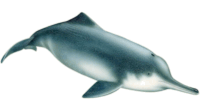
The Baiji Dolphin
Functionally extinct by 2006.IUCN: database entry.
Scientific name:
Lipotes vexillifer.
Picture source
An expedition organized by The Baiji Foundation in late 2006 sought evidence that Baiji white dolphins still existed in their only habitat, the Yangtze river in China. Scientists from six nations on two research vessels travelled for almost 3500 kilometres to the Yangtze Delta, and then retraced their route. They were equipped with sophisticated optical instruments and underwater microphones, but were unable to detect any surviving dolphins. The Foundation published a report on the expedition and declared the species functionally extinct. What does functionally extinct mean? It means too few potential breeding pairs remain to ensure that the species will survive.

West African Black Rhino
IUCN: database entry.
Scientific name:
Diceros bicornis longipes.
Photo source
In 2006, intensive surveys were conducted to locate any surviving West African black rhinos in their last refuges in northern Cameroon. After 48 field missions, no signs were found of their continued presence, although evidence of earlier poaching remained. The IUCN issued a news release in which the chairman of the African Rhino Specialist Group stated: "As a result this subspecies has been tentatively declared as extinct."
The Golden Toad

The Golden Toad is sometimes referred to as the Monteverde Toad or the Orange Toad. It was only known to exist on a high altitude ridge in Monteverde, Costa Rica. The IUCN database entry states: "In 1989, a single male was found, this was the last record of the species. Extensive searches since that time have failed to produce any more records." Its demise is attributed to a combination of factors, including airborne pollution and, due to its restricted range, global warming.
Spix's Macaw

This species of Macaw was native to Brazil. The IUCN database entry says the last known individual in the wild disappeared at the end of 2000, and that the species may well have gone extinct, primarily through trapping for trade and from habitat loss. "Any remaining population is likely to be tiny, and for these reasons it is treated as Critically Endangered (Possibly Extinct in the Wild)."
Po'o-uli

IUCN: database entry.
Scientific name:
Melamposops phaeosoma.
Photo source
The Po'o-uli, sometimes referred to as the Black-faced Honeycreeper, was first discovered in 1973 on the north-eastern slopes of Haleakala on the Hawaiian island of Maui. By mid-1997, only three individuals could be found. The IUCN database entry states: "A few unlocated individuals may exist in the wild, but the current wild population is functionally zero since the three known birds occur in separate, non-overlapping home ranges and no breeding is probable without intervention."
Kama'o
IUCN: database entry.
Scientific name:
Myadestes myadestinus.
The Kama'o was the larger variety of thrush on the Hawaiian island of Kaua'i (the smaller variety, Myadestes palmeri, is Critically Endangered). No sightings of this bird have been recorded since 1989, despite numerous intensive surveys.
Hawaiian Crow

The last Hawaiian crows were found only in the Kona Forest Unit of the Hakalau National Wildlife Refuge in Hawaii. The IUCN database entry states: "The last two known wild individuals of this species disappeared in 2002, so the species is now classified as Extinct in the Wild."
Pyrenean Ibex

IUCN: database entry.
Scientific name:
Capra pyrenaica pyrenaica.
Photo source
The Pyrenean Ibex was one of four subspecies of Spanish Ibex. The last known sighting of a Portuguese Ibex was in 1892, and the last Pyrenean Ibex died in January 2000. The two remaining subspecies, the Gredos Ibex and the Beceite Ibex, are classified as 'Near Threatened,' but there is a flourishing tourist industry which continues to organize hunting safaris to shoot and kill these animals.